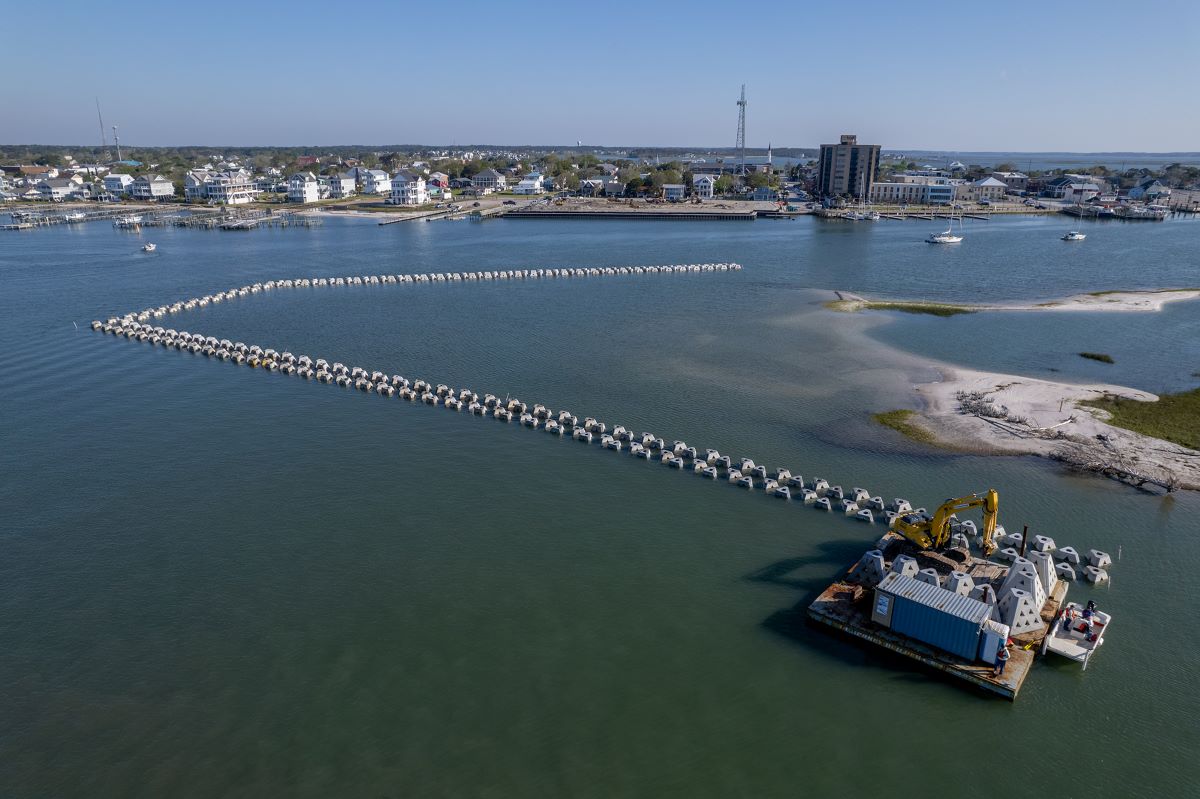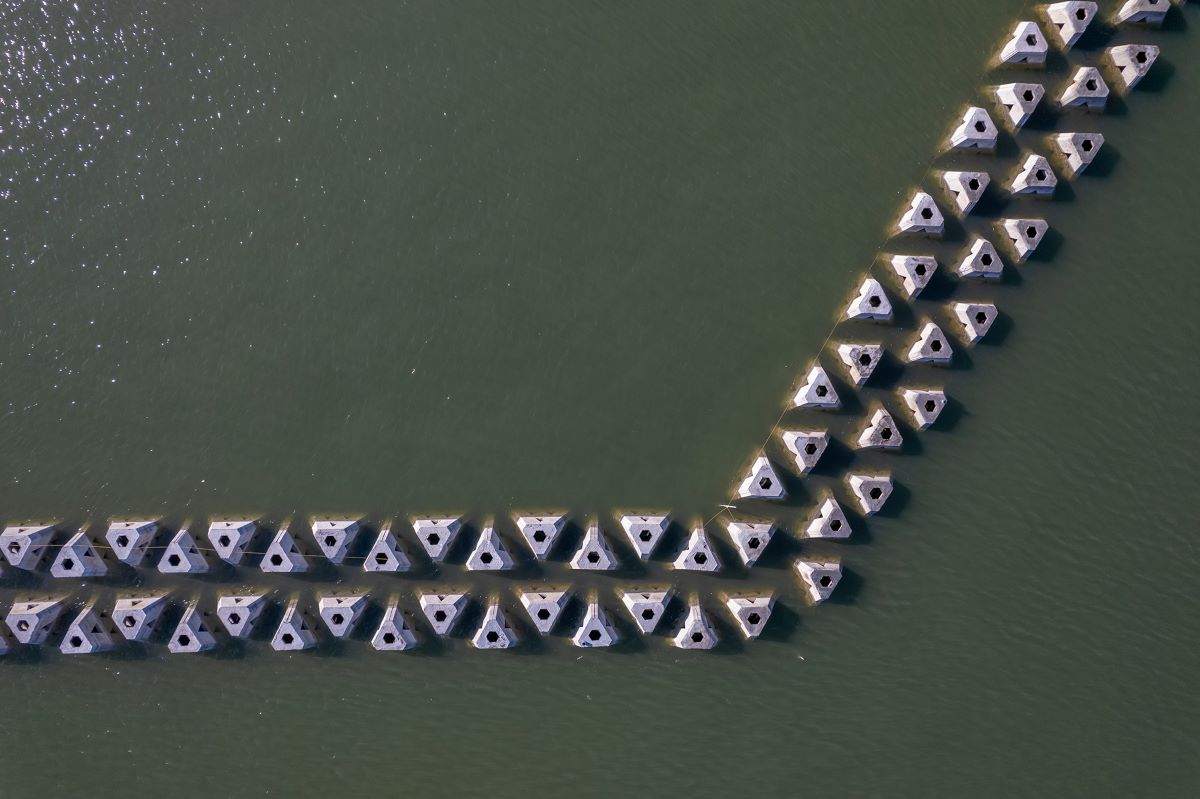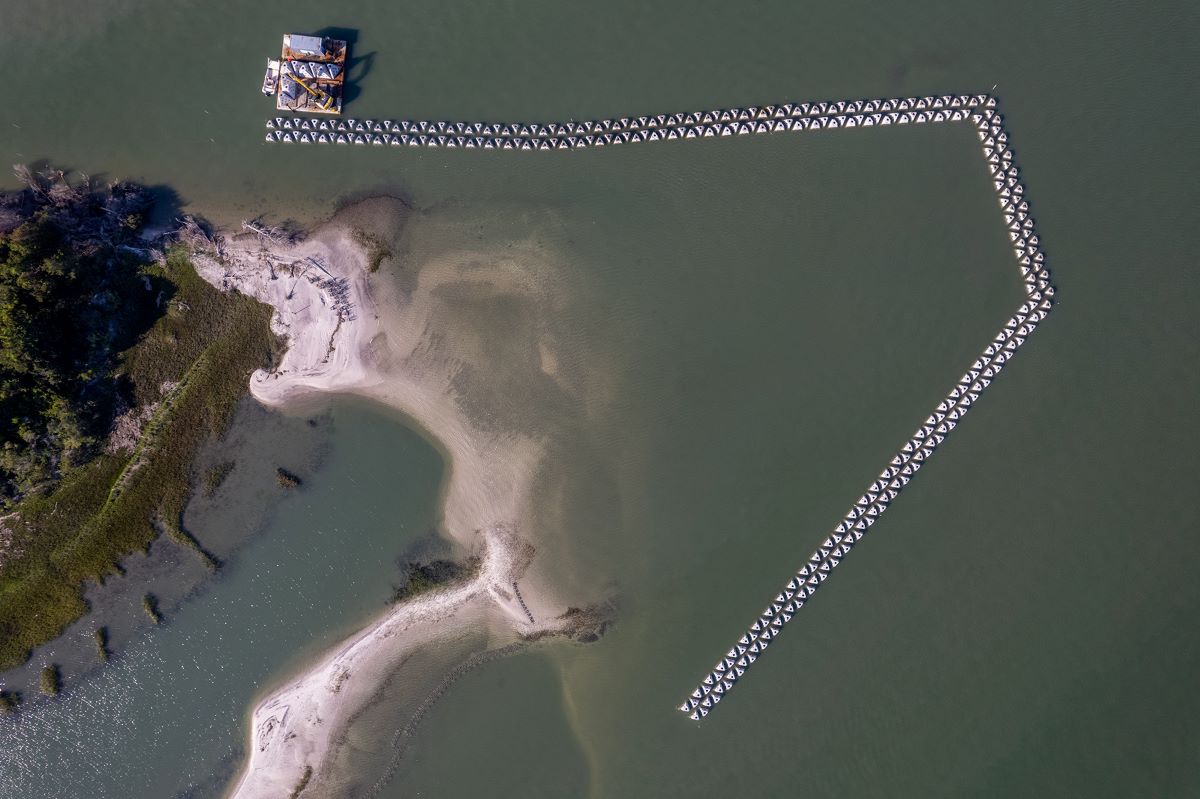
Anyone who has taken a stroll along downtown Morehead City’s waterfront in the last six or seven months may have noticed the hundreds of concrete, flat-top pyramids being strategically placed in rows around the rapidly eroding Sugarloaf Island.
Those are wave attenuation devices, or WADs, and part of a bigger, hybrid project to restore 3,520 linear feet of the barrier island’s shoreline.
Supporter Spotlight
Teaming up with the city on the effort to save the island are Sea & Shoreline LLC., a Florida-based aquatic restoration specialist with offices in the Carolinas, the nonprofit North Carolina Coastal Federation, engineering consultant Quible & Associates of Kitty Hawk, East Carolina University and Sandbar Oyster Co., a Beaufort-based habitat-restoration business.
“About 25 years ago, the Coastal Federation worked with the town of Morehead City to purchase the island. At that time, it had been slated for development — there were some condo plans in the works,” Coastal Federation Living Shoreline Division Lead Dr. Lexia Weaver explained. “Thanks to that purchase the island was able to be protected and conserved and be the natural resource it is for both for the public and the environment, as well but since that time the island has eroded significantly, as much as a football field.”

Sea & Shoreline Chief Sales and Marketing Officer Heather Herold told Coastal Review that if this erosion, which is taking place at an accelerated rate because of rising sea levels and wave energy, isn’t addressed, “the island could disappear, leaving the town vulnerable to climate-related events.”
Weaver added that the state invested $6.6 million to “protect this crucial natural asset from ongoing and worsening erosion, especially as a result of storm systems that are frequent to our coastal region.”
The money is from a 2022 appropriation of $2 million and $4.6 million in 2023. The town held a ceremony when the work began in mid-November to thank Sen. Norm Sanderson, R-Pamlico, who also represents Carteret County, Rep. Celeste C. Cairns, R-Carteret and Craven counties, and former Rep. Pat McElraft of Emerald Isle for supporting the project.
Supporter Spotlight
“Restoration methods for this project include reducing wave energy with an offshore living breakwater, planting seagrass behind the living breakwater, and planting a living shoreline on Sugarloaf Island,” officials said. “The living break water will not impede normal vessel traffic because it will be installed in areas too shallow for vessels to navigate safely at high speeds. The breakwater will also be staggared so that fishers can fish around them or pass through sections of the wave attenuators.”
Herold said the project is expected to bring back habitat and lead to benefits such as shoreline restoration, water quality improvement, resiliency, fish habitat, upland habitat and flood control.
Weaver said the design was based on a 2022 study of the island, as well as other studies. There was also evidence of significant erosion through mapping imagery combined with local knowledge and testimonials.
Plans call for a total of 1,200 wave attenuators to be installed around the island. The attenuators are 7 feet tall with a 9-foot base on each of the three sides, weighing in at around 7,500 pounds each.
Tina Harris, Sea & Shoreline’s pre-construction manager, said that as of Monday, a total of 443 attenuators are in the water. Of those, 376 had been deployed at the west end of the island, completing the attenuator portion of the project on that end of the island. Work is now taking place on the east end of the island where another 67 attenuators, or units, have been deployed. Harris said they have about 650 left to deploy.
“Once we complete the east end of the island, we will deploy units along the entire south side moving from the east back towards the west,” Harris said, adding they anticipate completing the attenuator placement part of the project in late June to early July of this year. “The nature of the project is heavily dependent on weather conditions.”
The patented attenuators being installed are to “stop the wave energy and accrete sand behind them to naturally renourish and rebuild the shoreline without the need for beach renourishment,” Herold explained, adding the attenuators provide water quality benefits, including attracting oysters that filter water. Other installed projects are filtering 22 million gallons of water per day.
Herold said that, together, “these measures will protect and restore the island, improve water quality, create essential fish habitat, protect shorebird nesting areas, and enhance the shoreline for recreational boaters to enjoy.”
Herold added that the patented device is created by Living Shoreline Solutions Inc. and made out of a pH-neutral mixture of concrete and fiber-mesh.
“We pour this mix into molds, allow for drying time, unmold them, let theme cure, then place them in the water in arrays that are pre-determined based upon scientific wave study modeling,” Herold said. As of Thursday, 682 total attenuators had been manufactured.
Harris added that the company manufactures the units at a Core Creek site and they are then moved the 10 miles by barge to Sugarloaf Island. Once the attenuators reach the island, the units are placed into the water using a large excavator, “where the units are leveled and aligned for maximum performance.”
In addition to the attenuators, Weaver said last week that two Oyster Catcher sills made by Sandbar Oyster Co. and totaling 550 feet have been put in place. These structures that resemble tables and made out of cement and plant-based cloth will continue to be manufactured and installed through the spring.
A total of 9,375 plugs of Spartina alterniflora, or smooth cordgrass, and 3,200 plugs of Uniola paniculata, or sea oats, were ordered as well and are scheduled to be planted this spring. Plans are to plant more in the spring of 2025, Weaver said.

They’re starting to see results of this work.
Weaver said that wave energy is already being reduced landward of the attenuators and sediment is already starting to accrete landward of the Oyster Catcher sills, promoting the natural expansion and growth of salt marsh grasses.
“The structures are also providing valuable habitat for fish, oysters and other marine life. Seagrass is expected to grow landward of the WADs in the quiescent waters,” Weaver added.
Morehead City Public Information Officer Anna Smith said Wednesday that the town “is grateful to be working with our partners on the Sugarloaf Island Restoration Project, and we are excited to already see positive progress,” adding that the “critical initiative would not be possible without $6.6 million in state legislative funding and the hard work” of the city’s partners and staff.
Post has been updated.







